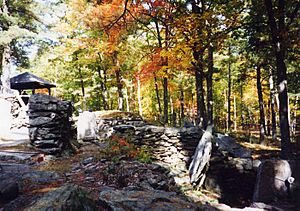America's Stonehenge facts for kids
For the granite monument erected in Georgia, see Georgia Guidestones
America's Stonehenge is a fascinating place in Salem, New Hampshire, in the United States. It has many large rocks and stone structures spread out over about 30 acres. Today, you can visit it as a fun outdoor area. There are snowshoe trails and even an alpaca farm! Many people who are interested in New Age ideas find this site very appealing.
People have many different ideas about how these stone structures were made and what they were used for. Some believe they were built by local farmers in the 1700s and 1800s. Others think a man named William Goodwin, who bought the land in 1937, built or moved many of the stones.
Some people even claim the site was built by Europeans a very long time ago, before Christopher Columbus came to America. However, most experts, like archaeologists, do not agree with this idea. They often call it "pseudoarchaeology" or think it might have been a trick in the early 1900s. Archaeologist David Starbuck believes that William Goodwin might have created much of what we see there today.
The site was first called Mystery Hill by William Goodwin. This was its official name until 1982. Then, it was renamed "America's Stonehenge." This new name was first used in a news article in the 1960s. The change was meant to make the site seem more important and ancient, like the famous Stonehenge in England. However, there is no proof that America's Stonehenge has any real connection to the one in England.
Contents
What is America's Stonehenge?
This unique site features many stone structures. These include walls, chambers, and large flat stones. Some stones have strange grooves or markings. People have wondered for a long time if these structures were built by ancient civilizations or by more recent settlers.
Who Built America's Stonehenge?
The first time this site was mentioned in writing was in a book from 1907 called History of Salem, N.H.. It talked about "Jonathan Pattee's Cave." Pattee lived in these woods about 70 years before the book was written. He used the caves for storage.
Jonathan Pattee's Cave. He had a house in these woods 70 years ago; took town paupers before the town farm was bought. This is a wild but beautiful spot, among rough boulders and soft pines, about which the most weird and fantastic tale might be woven. There are several caves still intact, which the owner used for storage purposes.
Many people think that Jonathan Pattee built the site in the 1800s. No clear evidence of European items from before Columbus's time has ever been found there.
William Goodwin's Influence
The history of America's Stonehenge became confusing because of William Goodwin. He was sure that the site proved that Irish monks, called Culdees, had lived there long before Columbus. He worked hard to share this idea with everyone.
The site has been changed over time. Some stones were removed for quarrying, which is when stones are dug out of the ground. Goodwin and others also moved stones around. They wanted to put them where they thought they originally belonged. It's possible that Goodwin built many of the structures we see now. Many of the stones even have marks from drilling, which happened during the quarrying.
The "Sacrificial Stone"
Some people have suggested very imaginative ideas about the site's origins. For example, there is a stone often called the "sacrificial stone." Some believe its grooves were made to channel blood. However, archaeologists have found that this stone looks very much like "lye-leaching stones" found on many old farms. Farmers used these stones to get lye from wood ashes. Lye was the first step in making soap. This suggests the stones were used for farming activities, not ancient rituals.
What Archaeologists Say
In 1982, David Stewart-Smith, who was in charge of fixing up Mystery Hill, dug up a large stone in a quarry near the main site. His team worked with the New Hampshire state archaeologist. They found many small pieces and chips of stone. They thought this showed that tools were made there, similar to how Native American people made stone tools. However, they couldn't figure out exactly when this happened.
Archaeologist Curtis Runnels has said that no items from the Bronze Age have been found at the site. He also noted that no one has found any European items from that time period anywhere in the New World. This means the idea of ancient European visitors building the site is not supported by archaeological finds.
Images for kids



